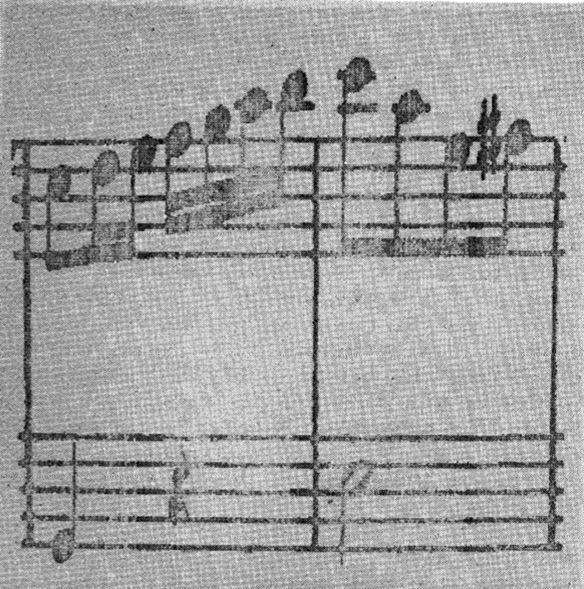|
Music OCR
Optical music recognition (OMR) is a field of research that investigates how to computationally read musical notation in documents. The goal of OMR is to teach the computer to read and interpret sheet music and produce a machine-readable version of the written music score. Once captured digitally, the music can be saved in commonly used file formats, e.g. MIDI (for playback) and MusicXML (for page layout). In the past it has, misleadingly, also been called "music optical character recognition". Due to significant differences, this term should no longer be used. History Optical music recognition of printed sheet music started in the late 1960s at the Massachusetts Institute of Technology when the first image scanners became affordable for research institutes. Due to the limited memory of early computers, the first attempts were limited to only a few measures of music. In 1984, a Japanese research group from Waseda University developed a specialized robot, called WABOT (WAseda roBOT ... [...More Info...] [...Related Items...] OR: [Wikipedia] [Google] [Baidu] |
Musical Notation
Music notation or musical notation is any system used to visually represent aurally perceived music played with instruments or sung by the human voice through the use of written, printed, or otherwise-produced symbols, including notation for durations of absence of sound such as rests. The types and methods of notation have varied between cultures and throughout history, and much information about ancient music notation is fragmentary. Even in the same time period, such as in the 2010s, different styles of music and different cultures use different music notation methods; for example, for professional classical music performers, sheet music using staves and noteheads is the most common way of notating music, but for professional country music session musicians, the Nashville Number System is the main method. The symbols used include ancient symbols and modern symbols made upon any media such as symbols cut into stone, made in clay tablets, made using a pen on papyrus ... [...More Info...] [...Related Items...] OR: [Wikipedia] [Google] [Baidu] |
Transcription (music)
In music, transcription is the practice of notating a piece or a sound which was previously unnotated and/or unpopular as a written music, for example, a jazz improvisation or a video game soundtrack. When a musician is tasked with creating sheet music from a recording and they write down the notes that make up the piece in music notation, it is said that they created a ''musical transcription'' of that recording. Transcription may also mean rewriting a piece of music, either solo or ensemble, for another instrument or other instruments than which it was originally intended. The Beethoven Symphonies transcribed for solo piano by Franz Liszt are an example. Transcription in this sense is sometimes called '' arrangement'', although strictly speaking transcriptions are faithful adaptations, whereas arrangements change significant aspects of the original piece. Further examples of music transcription include ethnomusicological notation of oral traditions of folk music, such as B ... [...More Info...] [...Related Items...] OR: [Wikipedia] [Google] [Baidu] |
International Journal Of Multimedia Information Retrieval
The ''International Journal of Multimedia Information Retrieval'' is a quarterly peer-reviewed scientific journal published by Springer Science+Business Media covering all aspects of multimedia information retrieval. It was established in 2012 and the editor-in-chief is Michael Lew (University of Leiden). Indexing and abstracting The journal is abstracted and indexed in Science Citation Index Expanded (Impact Factor 3.2, 2020), Inspec, ProQuest databases, and Scopus Scopus is Elsevier's abstract and citation database launched in 2004. Scopus covers nearly 36,377 titles (22,794 active titles and 13,583 inactive titles) from approximately 11,678 publishers, of which 34,346 are peer-reviewed journals in top-l .... References External links * Computer science journals English-language journals Publications established in 2012 Quarterly journals Springer Science+Business Media academic journals {{compu-journal-stub ... [...More Info...] [...Related Items...] OR: [Wikipedia] [Google] [Baidu] |
Optical Music Recognition Architecture By Rebelo (2012)
Optics is the branch of physics that studies the behaviour and properties of light Light or visible light is electromagnetic radiation that can be perceived by the human eye. Visible light is usually defined as having wavelengths in the range of 400–700 nanometres (nm), corresponding to frequencies of 750–420 te ..., including its interactions with matter and the construction of optical instruments, instruments that use or Photodetector, detect it. Optics usually describes the behaviour of visible light, visible, ultraviolet, and infrared light. Because light is an electromagnetic wave, other forms of electromagnetic radiation such as X-rays, microwaves, and radio waves exhibit similar properties. Most optical phenomena can be accounted for by using the Classical electromagnetism, classical electromagnetic description of light. Complete electromagnetic descriptions of light are, however, often difficult to apply in practice. Practical optics is usually done us ... [...More Info...] [...Related Items...] OR: [Wikipedia] [Google] [Baidu] |
Optical Music Recognition Architecture By Bainbridge And Bell (2001)
Optics is the branch of physics that studies the behaviour and properties of light, including its interactions with matter and the construction of instruments that use or detect it. Optics usually describes the behaviour of visible, ultraviolet, and infrared light. Because light is an electromagnetic wave, other forms of electromagnetic radiation such as X-rays, microwaves, and radio waves exhibit similar properties. Most optical phenomena can be accounted for by using the classical electromagnetic description of light. Complete electromagnetic descriptions of light are, however, often difficult to apply in practice. Practical optics is usually done using simplified models. The most common of these, geometric optics, treats light as a collection of rays that travel in straight lines and bend when they pass through or reflect from surfaces. Physical optics is a more comprehensive model of light, which includes wave effects such as diffraction and interference that cannot be ... [...More Info...] [...Related Items...] OR: [Wikipedia] [Google] [Baidu] |
Music Encoding Initiative
The Music Encoding Initiative (MEI) is an open-source effort to create a system for representation of musical documents in a machine-readable structure. MEI closely mirrors work done by text scholars in the Text Encoding Initiative (TEI) and while the two encoding initiatives are not formally related, they share many common characteristics and development practices. The term "MEI", like "TEI", describes the governing organization and the markup language. The MEI community solicits input and development directions from specialists in various music research communities, including technologists, librarians, historians, and theorists in a common effort to discuss and define best practices for representing a broad range of musical documents and structures. The results of these discussions are then formalized into the MEI schema, a core set of rules for recording physical and intellectual characteristics of music notation documents. This schema is expressed in an XML schema Language, with R ... [...More Info...] [...Related Items...] OR: [Wikipedia] [Google] [Baidu] |
Enharmonic
In modern musical notation and tuning, an enharmonic equivalent is a note, interval, or key signature that is equivalent to some other note, interval, or key signature but "spelled", or named differently. The enharmonic spelling of a written note, interval, or chord is an alternative way to write that note, interval, or chord. The term is derived from Latin ''enharmonicus'', from Late Latin ''enarmonius'', from Ancient Greek ἐναρμόνιος (''enarmónios''), from ἐν (''en'') and ἁρμονία (''harmonía''). Definition For example, in any twelve-tone equal temperament (the predominant system of musical tuning in Western music), the notes C and D are ''enharmonic'' (or ''enharmonically equivalent'') notes. Namely, they are the same key on a keyboard, and thus they are identical in pitch, although they have different names and different roles in harmony and chord progressions. Arbitrary amounts of accidentals can produce further enharmonic equivalents, such as B ... [...More Info...] [...Related Items...] OR: [Wikipedia] [Google] [Baidu] |
Synthesizer
A synthesizer (also spelled synthesiser) is an electronic musical instrument that generates audio signals. Synthesizers typically create sounds by generating waveforms through methods including subtractive synthesis, additive synthesis and frequency modulation synthesis. These sounds may be altered by components such as filters, which cut or boost frequencies; envelopes, which control articulation, or how notes begin and end; and low-frequency oscillators, which modulate parameters such as pitch, volume, or filter characteristics affecting timbre. Synthesizers are typically played with keyboards or controlled by sequencers, software or other instruments, and may be synchronized to other equipment via MIDI. Synthesizer-like instruments emerged in the United States in the mid-20th century with instruments such as the RCA Mark II, which was controlled with punch cards and used hundreds of vacuum tubes. The Moog synthesizer, developed by Robert Moog and first sold in 1964, ... [...More Info...] [...Related Items...] OR: [Wikipedia] [Google] [Baidu] |
Journal Of New Music Research
''Journal of New Music Research'' is a peer-reviewed academic journal covering research on musicology (including music theory), philosophy, psychology, acoustics, computer science, engineering, and other disciplines. Articles deal with theory, analysis, composition, performance, uses of music, instruments, and other music technologies. The journal was established in 1972 under the title ''Interface'' and is published by Routledge. The editor-in-chiefs are Johanna Devaney ( Brooklyn College and the Graduate Center, CUNY) and David Meredith (Aalborg University). Abstracting and indexing The journal is abstracted and indexed in: According to the ''Journal Citation Reports'', the journal has a 2011 impact factor The impact factor (IF) or journal impact factor (JIF) of an academic journal is a scientometric index calculated by Clarivate that reflects the yearly mean number of citations of articles published in the last two years in a given journal, as ... of 0.481. Refer ... [...More Info...] [...Related Items...] OR: [Wikipedia] [Google] [Baidu] |
Pattern Recognition
Pattern recognition is the automated recognition of patterns and regularities in data. It has applications in statistical data analysis, signal processing, image analysis, information retrieval, bioinformatics, data compression, computer graphics and machine learning. Pattern recognition has its origins in statistics and engineering; some modern approaches to pattern recognition include the use of machine learning, due to the increased availability of big data and a new abundance of processing power. These activities can be viewed as two facets of the same field of application, and they have undergone substantial development over the past few decades. Pattern recognition systems are commonly trained from labeled "training" data. When no labeled data are available, other algorithms can be used to discover previously unknown patterns. KDD and data mining have a larger focus on unsupervised methods and stronger connection to business use. Pattern recognition focuses more on the si ... [...More Info...] [...Related Items...] OR: [Wikipedia] [Google] [Baidu] |
Excerpt From Nocturne Op
{{Short pages monitor ... [...More Info...] [...Related Items...] OR: [Wikipedia] [Google] [Baidu] |
Website
A website (also written as a web site) is a collection of web pages and related content that is identified by a common domain name and published on at least one web server. Examples of notable websites are Google, Facebook, Amazon, and Wikipedia. All publicly accessible websites collectively constitute the World Wide Web. There are also private websites that can only be accessed on a private network, such as a company's internal website for its employees. Websites are typically dedicated to a particular topic or purpose, such as news, education, commerce, entertainment or social networking. Hyperlinking between web pages guides the navigation of the site, which often starts with a home page. Users can access websites on a range of devices, including desktops, laptops, tablets, and smartphones. The app used on these devices is called a Web browser. History The World Wide Web (WWW) was created in 1989 by the British CERN computer scientist Tim Berners-Lee ... [...More Info...] [...Related Items...] OR: [Wikipedia] [Google] [Baidu] |







